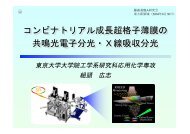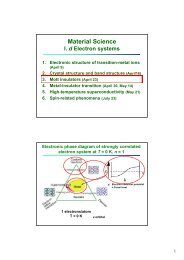Thesis High-Resolution Photoemission Study of Kondo Insulators ...
Thesis High-Resolution Photoemission Study of Kondo Insulators ...
Thesis High-Resolution Photoemission Study of Kondo Insulators ...
You also want an ePaper? Increase the reach of your titles
YUMPU automatically turns print PDFs into web optimized ePapers that Google loves.
68 Chapter 5. Temperature Dependence <strong>of</strong> the <strong>High</strong>-<strong>Resolution</strong> <strong>Photoemission</strong> ...<br />
the spectra by the FD distribution function (convoluted with a Gaussian corresponding<br />
to the instrumental resolution) [5.16–18] as shown in the lower panel <strong>of</strong> Fig. 5.4. We<br />
present the spectral DOS up to ∼ 2kBT above EF where the FD function falls <strong>of</strong>f to<br />
∼ 0.1. The results show that the DOS with a V-shaped dip varies with temperature<br />
in such a wide energy region as ∼ 100 meV around EF . This widely extended dip<br />
compared with the activation energy <strong>of</strong> 6 meV has already been implied in the previous<br />
measurements on polycrystalline YbB12 [5.5]. Here, the improved energy resolution<br />
has clarified the shape <strong>of</strong> the dip at low temperatures: The closer to EF one goes,<br />
the steeper the slope appears. From the measurements on polycrystals at ∼ 30 K we<br />
estimated that the spectral DOS at EF was depressed by ∼ 25% compared with that<br />
<strong>of</strong> LuB12. Here, the depression amounts to more than 40% in going from 305 K to 6 K<br />
because <strong>of</strong> the improved energy resolution and the extended temperature range. The<br />
width <strong>of</strong> the sharp cusp-like depression in the very vicinity <strong>of</strong> EF , which has not been<br />
observed in the previous work, is ∼ 10 meV. This energy scale falls in the same range as<br />
the transport gap <strong>of</strong> 2∆act ∼ 12 meV. The appearance <strong>of</strong> this sharp depression only at<br />
low temperatures (6 to 75 K) is parallel to the temperature dependence <strong>of</strong> the magnetic<br />
susceptibility and the electrical resistivity: Below Tmax ∼ 75 K the magnetic susceptibility<br />
decreases due to the missing Pauli paramagnetism. The electrical resistivity<br />
follows an activated form only below ∼ 50 K. Above ∼ 100 K it decreases slowly with<br />
temperature following − log T , like a metallic <strong>Kondo</strong> material[5.19]. Except for the<br />
residual DOS at EF at low temperatures the spectra imply that a narrow gap is formed<br />
at low temperatures while a Fermi edge exists at high temperatures. Here, we note<br />
that the bottom <strong>of</strong> the pseudogap in YbB12 is not located exactly at EF but slightly<br />
below EF . This may indicate that the dip feature are caused by hybridization <strong>of</strong> the<br />
conduction-band states with the 4f states since the 4f states are located largely below<br />
EF .<br />
A recent reflectivity study by Okamura et al.[5.20] has also revealed two energy<br />
scales in the spectrum <strong>of</strong> YbB12 as shown in Fig. 5.3: a gap <strong>of</strong> ∼ 25 meV (threshold)<br />
with a shoulder at ∼ 40 meV develops below 70 K in the optical conductivity (Fig. 5.3<br />
(b)). They are superposed on a broad dip with a shoulder at ∼ 0.25 eV, which is present<br />
at all temperatures (Fig. 5.3 (b)). Okamura et al. have attributed the broad structure<br />
to a 4f-5d transition, which has no direct relation with the peculiar behavior <strong>of</strong> the<br />
<strong>Kondo</strong> insulator. That the energy <strong>of</strong> the optical threshold is larger than the transport<br />
gap (2∆act ∼ 12 meV) is characteristic <strong>of</strong> an indirect gap, implying a formation <strong>of</strong> a






